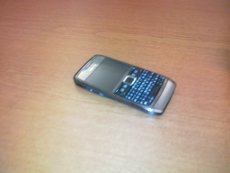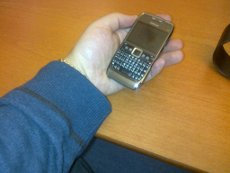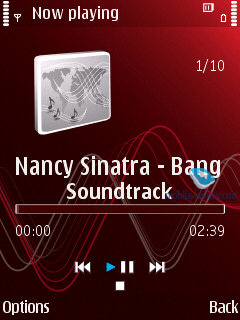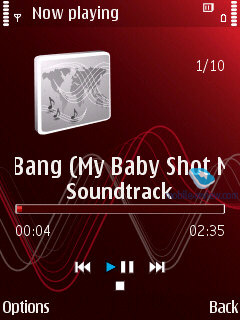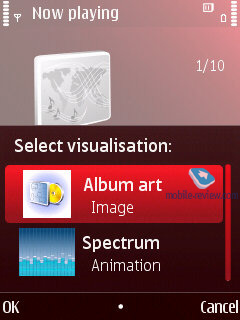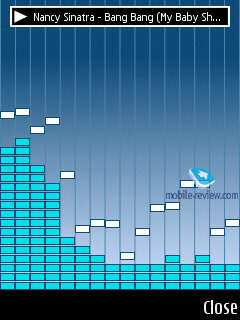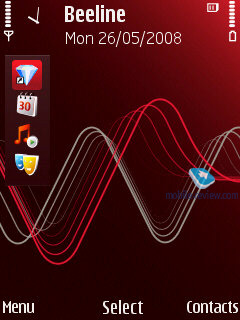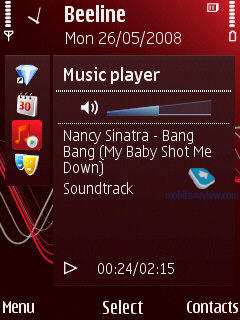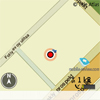|
|
Preview of GSM/UMTS-smartphone Nokia E55
Live images of the Nokia E55
Table of contents:
- Positioning
- Design, Size, Controls
- Display
- Keypad
- Battery
- Memory
- Performance
- USB, Bluetooth, WiFi
- Camera
- Software and Applications
- GPS
- Impressions
Sales package
- Nokia E55
- Charger (AC-10)
- Nokia Charger Adapter CA-146C
- 1500 mAh Li-Ion battery (BP-4L)
- Nokia Stereo headset HS-48
- USB data cable (CA-101)
- 2 GB microSD memory card
- User Guide
- Nokia PC Suite (v7.2) (on microSD memory card)
Services enabled in the phone:
- Files on Ovi, 60-day subscription with 1GB of disk space at your disposal
- Maps, 10 one-day licenses, valid for 3 months from the day of purchase
- Nokia Messaging, life-time subscription
Positioning
Frankly speaking, as it stands today, the Nokia E55’s future appears to be extremely vague at best. And the reason for that is not tough competition on the outside; in fact the E55 will be eaten up by Nokia’s very own Eseries models that are either on their way to the market or already available. The idea behind the Nokia E55 is pretty simple – a pocketable phone with a focus on calling features, long battery life and a semiQWERTY-keyboard. All in all, it’s more of a link connecting the Nokia E51 and Nokia E63. But that’s not all, the E55 also complements the Nokia E63 in the way of thumbboard type, making Nokia’s business-savvy line-up complete in this respect. At the same time, the very existence of this phone opens a Pandora box for Nokia, since with the arrival of the Nokia 6700 there’ll be more than one option to choose from as far as their phones with emphasis on calling features go.

However, the Nokia E55 will appeal to avid texters who, for some reason, can’t handle conventional QWERTY keypads. Needless to say, this niche is so narrow that it’s not even worth considering. Plus, the E55’s localization will be quite problematic for many regions because of its keypad setup. That’s why it won’t be available in Russia, along with all phones of this type. By and large, Nokia needs to equip their semiQWERTY solutions with touch-sensitive displays, but that’s not something we should expect in 2009.

Further complicating things for the Nokia E55 is the soon-to-be-announced replacement for the E51 that will retail at the 265-275 Euro price point, allowing the original E51 to stay in the market with its current price tag, yet ruining the E55’s last chance for success. So at the end of the day Nokia has got another carrier-tailored solution on their hands that will be distributed in select regions. In essence, that’s the only way it’ll survive, although had it not had such an array of alternatives in Nokia’s own portfolio, it would’ve been quite a success.
Back to the table of contents >>>
Design, Size, Controls
As of today, the Nokia E55 comes in a choice of two colors – black and silver. Both look appealing, plus some carriers will get extra color schemes, such as red, blue and titan. While they’ve got a whole bunch of other colors in stock, the question is whether all of them will see release, and I have some serious doubts about that.

The phone is housed in a no-frills candybar design, measuring 116.5x49x9.9 mm – this combination of width and slimness makes the E55 quite a palm-friendly device. Interestingly, Nokia’s engineers had to trim the phone’s back cover in order to reach the required thickness, so when you actually examine it at first it appears to be made of strengthened plastic, but as it turns out, it’s fully metal, although considerably thinner than the battery cover of, say, the Nokia E71.



At the say time, they managed to keep the E55’s weight below 100 grams – it tipped our scales at just 95 grams.
Nokia E55 vs Nokia E51:
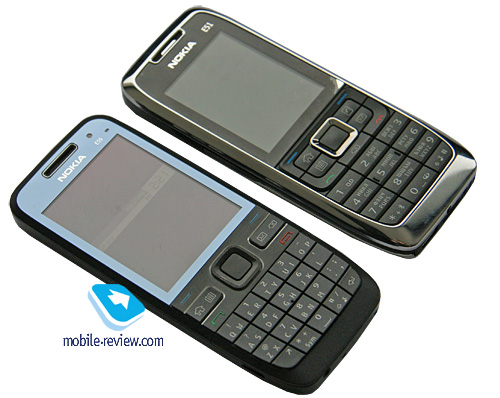
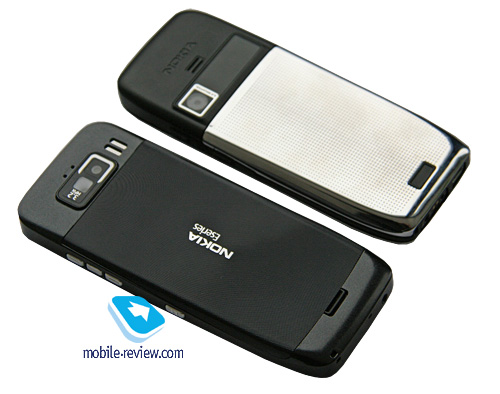
Nokia E55 vs Nokia E75:



Housed on the right-hand spine are the phone’s volume controls, separated by the dedicated voice button, further down is the camera shutter key. On the left there is a naked microUSB socket. The top end of the E55 features the power button along with 3.5 mm audio jack, while at the bottom there are the charger slot and lanyard eyelet.

Build quality was never an issue with the E55, however you’ll be better off not dropping it on hard surfaces – the battery cover latch leaves much to be desired.


Topping the display are the forward-facing video camera and ambient light sensor.

Back to the table of contents >>>
Display
The handset comes equipped with a 2.4-inch QVGA (240x320 pixels) display, capable of showing up to 16M colors, presenting you with quite a bright picture that remains visible in various environments (although it’s still inferior to some of Nokia’s very own latest-gen phones). All in all, the E55 packs in a likable screen that can accommodate up to 8 text and up to 3 service lines. In some modes, though, you may get up to 14 text lines. All fonts are sharp and easy to read.
Back to the table of contents >>>
Keypad
The E55’s keyboard sports quite sizable easy-to-handle buttons. While it’s called “semiQWERTY” all this really means is that these are regular keys with two rows of symbols engraved on them. Unlike the Sony Ericsson M600, the E55 doesn’t utilize the rocker-style setup, instead it requires you to push the same button twice to get to the other symbol. All keys are evenly lit in white.



While this keypad is considerably handier than that of the average phone, it can’t stand up to the level of comfort delivered by an ordinary QWERTY thumbboard, such as that found in the Nokia E71.
Unlike other models, the E55 doesn’t come with a dedicated phonebook button, instead it carries the “C” key, which brings the total number of application shortcuts down to three.
Back to the table of contents >>>
Battery
The handset utilizes a 1500 mAh Li-Ion battery (BL-4L), rated for 672 (in other words, 28 days!) hours of standby, 8 hours of talk time, 18 hours of music, 190 minutes of video recording (top quality settings) and 240 minutes of video playback.


In Moscow the E55 lasted around 4.5-5 days with moderate use (up to three hours of calls and up to one hour of music, a dozen of images, several minutes of video) It takes the battery just shy of 2 hours to charge from empty to full.
Below is our chart of battery times we managed to squeeze out of the Nokia E55:
- Video playback – 4.5 hours
- WEB-surfing (EDGE) - 4.5 hours
- Music (in earphones) – 17.5 hours
- Radio - 25 hours
- GPS – 4 hours
Back to the table of contents >>>
Memory
The device comes equipped with 128 Mb of RAM, after first launch you will get around 76 Mb of free memory at your disposal, which is enough for running a dozen applications and browsing "heavy-duty" web-pages - the word "slow-down" is definitely not in the E55’s vocabulary. Also it offers the user almost 50 Mb of storage, where any data can be stored.
The E55 deals with microSD memory cards (hot-swappable), the phone comes packaged with a 2 Gb unit. There are no restrictions as far as memory card’s size is concerned – our handset easily identified a 32Gb card.
Back to the table of contents >>>
Performance
The phone is based on the same platform as the Nokia 5630 XpressMusic, and it scored the same in all performance tests we put it through. In our review of the 5630 XpressMusic we pointed out that it wasn’t based on a 600 MHz ARM11 CPU, and just to make sure we took our sample apart and checked it out – no 600 MHz processor inside. However, we were contacted by Nokia’s employees who showed us that it was build on a 600 MHZ CPU after all. This new generation of products includes a number of phones and the E55 is one of them. As soon as we find out more about this CPU collision, we’ll update our review of the Nokia 5630 XpressMusic.
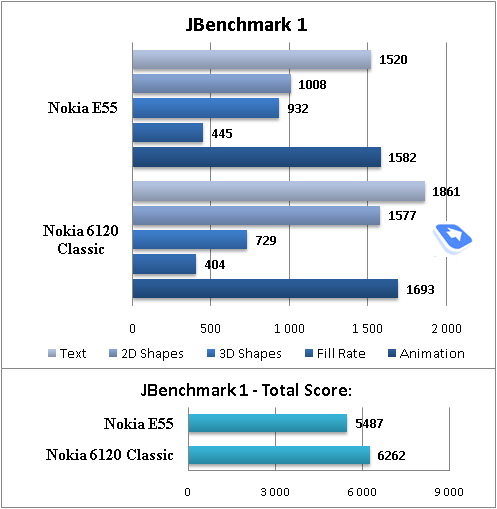
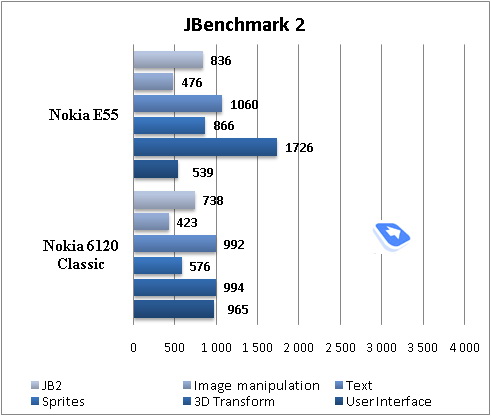
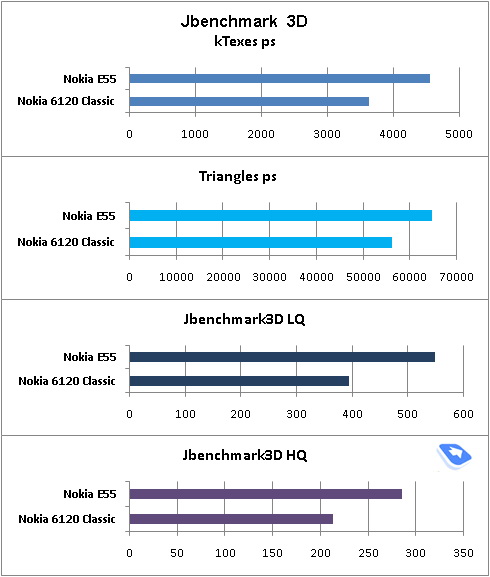
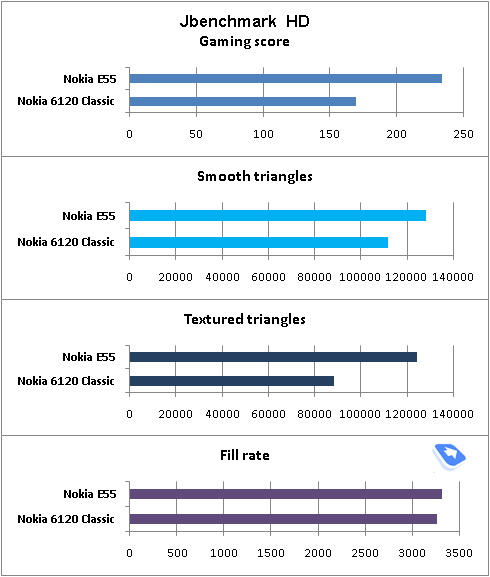
Back to the table of contents >>>
USB, Bluetooth, WiFi
USB. You pick one of these 3 connection modes in the USB settings of the E55:
- Data Transfer (Mass Storage USB) – memory cards is available, no drivers required, as your OS identifies the handset automatically.
- PC Suite – used for device management via Nokia PC Suite, enables all features of the phone, data backup etc.
- Image Print – no explanation required.
Data transfer speeds top out at around 1 Mb/s.
Bluetooth. The phone comes with Bluetooth v2.0, with support for EDR. The following profiles are supported:
- A2DP
- AVCRP
- BIP-ImagePush
- DUN-GW
- FT-Server
- HandsFree-AG (1.0)
- Headset-AG
- OBEX
- OPP-Client
- OPP-Server
- SIM Access-Server
The top speed you can get with the E55's Bluetooth connection is around 100 Kb/s. We also tested its A2DP profile in pair with the Sony Ericsson DS970 headset, which worked just fine - we managed our play list, skipped within tracks and adjusted volume seamlessly, however we couldn't make current track's title show up on the headset's display.
WiFi. The phone supports 802.11 b/g, and comes equipped with network wizard.
Back to the table of contents >>>
Camera
Much like the Nokia 5630 XpressMusic, this phone comes armed with a low-end camera module with “Full Focus” (EDOF), although mind the fact that it doesn’t have autofocus – on the contrary, it has a fixed focal point and shoots only objects that’s 50 cm away or farther. While Nokia claims that this technology allows for much quicker shots (since you don’t need to make the camera focus), I urge you to disregard this misinformation, as it’s just another way of saying that the E55 packs in an entry-level camera without autofocus. Unfortunately, we can’t offer you a plethora of image samples just yet. The handset’s video recording department is limited to VGA resolution and 15 FPS.

Back to the table of contents >>>
Software and Applications
The ESeries devices have always been worlds apart from other S60-powered devices in the way of software. Some apps and options that were tested on these phones in the first place are now becoming par for the course in the rest of the company's portfolio, but some still remain the trademark features of the ESeries. On this front the E55 is almost identical to the Nokia E71, although it has got some updates, such as a revamp in the mail client that now supports html, as well as new filters. Plus, it's easier to setup now and, essentially, it employs email.nokia.com service that's now available on Nokia's phones as a pre-installed application.
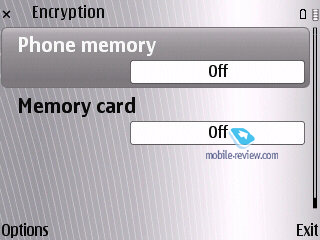
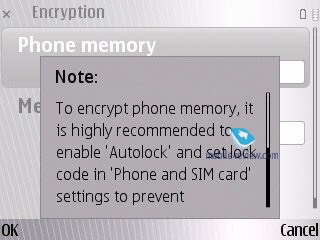
The Nokia E55 sports a unique phonebook, calendar and some other features that are very different from those generic applications built into S60 3rd edition FP2. Let's see what new feats and abilities the E55 brings to the table.
Music department. Since the E55 is almost an exact copy of the Nokia 5730 XpressMusic, it packs in a dedicated audio chip, meaning that it surpasses all previous Eseries-branded phones on this front, plus the E55's standard 3.5 mm audio jack allows the user to utilize a pair of custom earphones.
Back to the table of contents >>>
GPS
The E55’s bundled GPS receiver and Maps 2.0 package (can be updated to version 3.0) are nothing out of the ordinary.
Back to the table of contents >>>
Impressions
Call quality was never an issue with the E55, as it easily lived up to our expectations of a Nokia-branded phone. Ring tones sounded quite loud; we also found the E55’s vibro alert was average strength-wise.
The E55 is set to arrive in May at a price point of 265 Euro (before taxes and subsidies). On balance, it’s a fine device that complements the music-minded Nokia 5630 XpressMusic and comes with a couple of metallic accents, as well as some Eseries-specific software features.
The main thing going for the Nokia E55 is its battery time – for some this will be a very compelling argument, but personally I find it to be a very niche offering that won’t be very popular primarily because of the competition it faces inside Nokia’s portfolio.
Related links
Back to the table of contents >>>
Eldar Murtazin (eldar@mobile-review.com)
Translated by Oleg Kononosov (oleg.kononosov@mobile-review.com)
Published — 31 March 2009
Have something to add?! Write us... eldar@mobile-review.com
|
News:
[ 31-07 16:21 ]Sir Jony Ive: Apple Isn't In It For The Money
[ 31-07 13:34 ]Video: Nokia Designer Interviews
[ 31-07 13:10 ]RIM To Layoff 3,000 More Employees
[ 30-07 20:59 ]Video: iPhone 5 Housing Shown Off
[ 30-07 19:12 ]Android Fortunes Decline In U.S.
[ 25-07 16:18 ]Why Apple Is Suing Samsung?
[ 25-07 15:53 ]A Few Choice Quotes About Apple ... By Samsung
[ 23-07 20:25 ]Russian iOS Hacker Calls It A Day
[ 23-07 17:40 ]Video: It's Still Not Out, But Galaxy Note 10.1 Gets An Ad
[ 19-07 19:10 ]Another Loss For Nokia: $1 Billion Down In Q2
[ 19-07 17:22 ]British Judge Orders Apple To Run Ads Saying Samsung Did Not Copy Them
[ 19-07 16:57 ]iPhone 5 To Feature Nano-SIM Cards
[ 18-07 14:20 ]What The iPad Could Have Looked Like ...
[ 18-07 13:25 ]App Store Hack Is Still Going Strong Despite Apple's Best Efforts
[ 13-07 12:34 ]Infographic: The (Hypothetical) Sale Of RIM
[ 13-07 11:10 ]Video: iPhone Hacker Makes In-App Purchases Free
[ 12-07 19:50 ]iPhone 5 Images Leak Again
[ 12-07 17:51 ]Android Takes 50%+ Of U.S. And Europe
[ 11-07 16:02 ]Apple Involved In 60% Of Patent Suits
[ 11-07 13:14 ]Video: Kindle Fire Gets A Jelly Bean
Subscribe
|





























